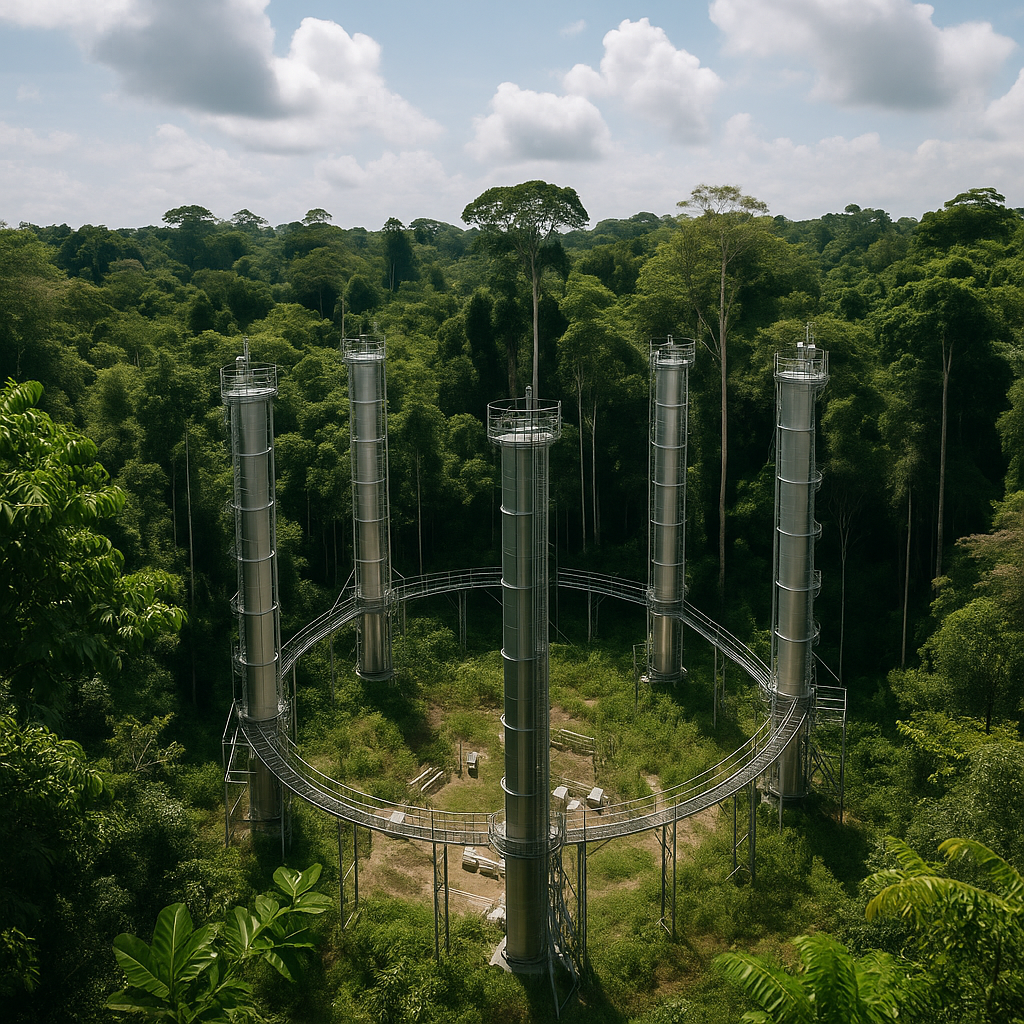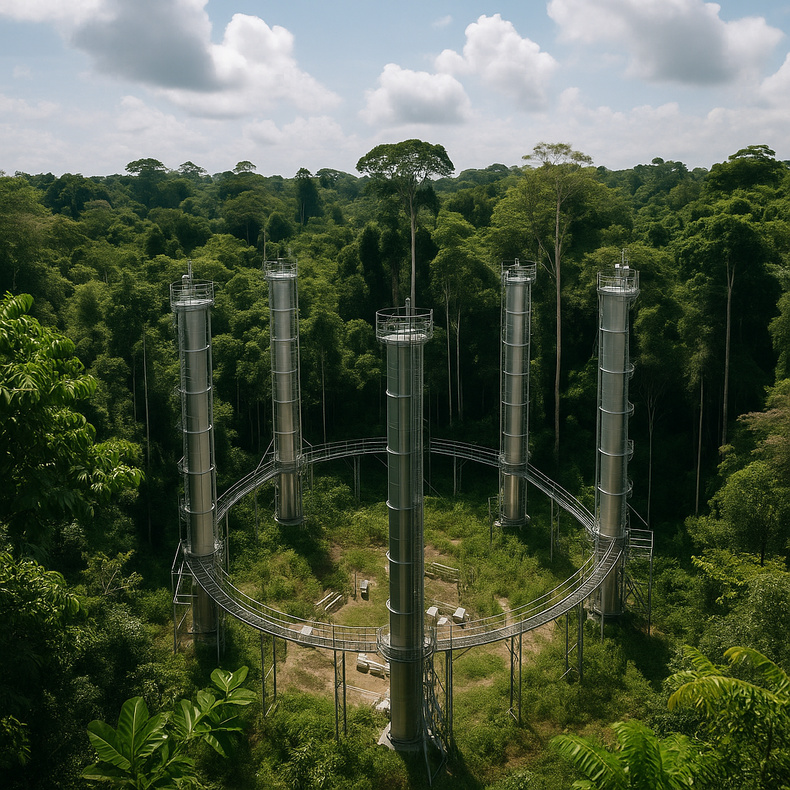Deep inside Brazil’s vast rainforest, scientists are running an unprecedented experiment designed to glimpse the Earth’s future. Using advanced atmospheric technology, researchers are turning a section of the Amazon forest into a “climate time machine” — artificially replicating the high-carbon world expected decades from now. The project, called AmazonFACE, aims to answer one of the most urgent questions in global climate science: how will the world’s largest tropical forest respond to the rising carbon dioxide levels and shifting climate conditions of the mid-21st century?
The experiment, situated near Manaus, the Amazon’s largest city, represents a scientific breakthrough and a powerful symbol as Brazil prepares to host the COP30 United Nations Climate Summit in Belém next month. The stakes could not be higher. The Amazon is one of the planet’s most vital carbon sinks, absorbing roughly 5% of global CO₂ emissions each year. Yet deforestation, rising temperatures, and changing rainfall patterns are already weakening its ability to regulate the global climate. Understanding how the rainforest will function in a warmer, carbon-rich atmosphere could shape not only Brazil’s environmental policy but the future of international climate negotiations.
A Laboratory Built Inside the Living Forest
At the heart of the AmazonFACE project stands a remarkable engineering feat: six giant rings of steel towers, each encircling a cluster of 50 to 70 mature rainforest trees. These towers pump carefully measured amounts of carbon dioxide into the air above the canopy, mimicking atmospheric conditions projected for the next several decades. The experiment divides the rings into two groups — three infused with elevated CO₂ levels and three left untouched as controls.
For scientists like Carlos Quesada of Brazil’s National Institute for Amazon Research (INPA), who coordinates the project alongside the State University of Campinas, the goal is to “recreate the atmosphere of the future.” Unlike laboratory simulations, this system operates in the open air, allowing researchers to observe how natural rainforest ecosystems — not isolated plants — respond to long-term exposure to carbon-rich conditions. Each ring bristles with sensors that record temperature, humidity, CO₂ concentration, and the trees’ respiration and photosynthetic activity every few minutes.
By studying how the forest exchanges gases with the atmosphere, researchers hope to identify whether the Amazon will remain a “carbon sink,” absorbing greenhouse gases, or shift into a “carbon source,” releasing more than it absorbs. This distinction could determine whether global climate targets remain achievable or not. As Quesada explained, “We’re not just studying the forest; we’re studying the planet’s future behavior.”
Why the Amazon Matters in a Warming World
The Amazon’s ability to absorb carbon dioxide and regulate rainfall makes it a critical stabilizer of the global climate system. Yet its resilience is now in question. Over the past two decades, repeated droughts, deforestation, and forest fires have pushed large parts of the biome toward a dangerous tipping point. Scientists warn that continued degradation could trigger a shift from humid rainforest to dry savanna — a transformation that would release billions of tons of carbon and accelerate global warming.
This is why the timing of AmazonFACE is strategic. With COP30 approaching, Brazil’s government wants to position itself as a leader in tropical climate research and forest conservation. Policymakers hope that data from this experiment will strengthen their case for increased international funding and cooperation in protecting the Amazon Basin. By hosting COP30 in Belém, where the Amazon River meets the Atlantic Ocean, Brazil aims to spotlight the forest as both a victim of climate change and a critical solution to it.
The experiment also feeds into a wider scientific debate about how elevated CO₂ affects vegetation. In temperate zones, such as North America and Europe, similar “Free-Air CO₂ Enrichment” (FACE) experiments have shown that higher carbon concentrations can initially stimulate plant growth — the so-called “fertilization effect.” But in tropical ecosystems like the Amazon, the response is uncertain. Nutrient-poor soils, extreme humidity, and complex species interactions may limit how much benefit plants can derive from excess carbon. Understanding these mechanisms could redefine global carbon-cycle models and refine the climate projections that guide policymaking.
Turning the Forest Into a Window to the Future
AmazonFACE marks the first time such an experiment has been conducted in a tropical forest at this scale. The project’s infrastructure — largely financed by Brazil’s federal government and supported by international partners — integrates both engineering precision and ecological sensitivity. Sophisticated sensors monitor how leaves photosynthesize, how roots store carbon, and how the forest exchanges moisture with the atmosphere. Data are transmitted continuously, offering a real-time picture of how the ecosystem responds to fluctuating environmental stressors such as heatwaves and rainfall variation.
Forestry engineer Gustavo Carvalho, part of the core research team, describes the site as a “living laboratory.” He explains that once the system begins full operation, scientists will adjust the carbon dioxide concentration inside the rings to match projections for mid-century — approximately 550 parts per million, compared to the current global average of around 420 ppm. “If the models predict 2050 or 2060 atmospheric conditions, we replicate those here,” Carvalho said. “It’s as if we can walk into a fragment of the future and see how the forest breathes.”
The implications go beyond pure science. Should the Amazon show signs of reduced carbon absorption or physiological stress under these simulated conditions, the findings could reshape international climate negotiations. It would suggest that nature’s buffering capacity — long counted on to buy humanity time — is diminishing faster than expected. Conversely, if the forest demonstrates resilience and adaptive capacity, it would reinforce the importance of protecting intact ecosystems as a central pillar of climate mitigation.
The Broader Stakes for Brazil and the World
As Brazil prepares to welcome world leaders and climate experts to COP30, the AmazonFACE project serves as both a scientific milestone and a political statement. It underscores Brazil’s intent to lead on environmental science after years of deforestation and policy reversals under previous administrations. For President Luiz Inácio Lula da Silva’s government, which has pledged to end illegal deforestation by 2030, showcasing the Amazon as a global climate research hub could help attract international investment and reinforce Brazil’s credibility in sustainability diplomacy.
The timing is also geopolitically significant. Global carbon emissions remain near record highs, and international commitments are lagging behind the targets set in the Paris Agreement. The Amazon’s fate — whether it continues absorbing CO₂ or becomes a source of it — could influence the pace at which the world warms. For many scientists, the forest represents a final buffer against runaway climate change.
Yet the challenge extends beyond emissions. The Amazon regulates rainfall across South America, feeding rivers that sustain agriculture from Brazil’s interior to Argentina’s plains. If rising temperatures disrupt these systems, the consequences will ripple through food production, energy supply, and urban water security. As researchers at AmazonFACE simulate the world to come, they are effectively probing how much longer the Earth’s natural systems can shield humanity from its own excesses.
The Amazon “time machine” thus stands as both a warning and a hope — a reminder that understanding the future is no longer theoretical. In a forest where each leaf measures the pulse of the planet, scientists are reading the signals that will define the climate negotiations unfolding thousands of miles away. As Brazil readies for COP30, the lessons drawn from this living experiment may prove as pivotal as any policy drafted in conference halls.
(Source:www.reuters.com)
The experiment, situated near Manaus, the Amazon’s largest city, represents a scientific breakthrough and a powerful symbol as Brazil prepares to host the COP30 United Nations Climate Summit in Belém next month. The stakes could not be higher. The Amazon is one of the planet’s most vital carbon sinks, absorbing roughly 5% of global CO₂ emissions each year. Yet deforestation, rising temperatures, and changing rainfall patterns are already weakening its ability to regulate the global climate. Understanding how the rainforest will function in a warmer, carbon-rich atmosphere could shape not only Brazil’s environmental policy but the future of international climate negotiations.
A Laboratory Built Inside the Living Forest
At the heart of the AmazonFACE project stands a remarkable engineering feat: six giant rings of steel towers, each encircling a cluster of 50 to 70 mature rainforest trees. These towers pump carefully measured amounts of carbon dioxide into the air above the canopy, mimicking atmospheric conditions projected for the next several decades. The experiment divides the rings into two groups — three infused with elevated CO₂ levels and three left untouched as controls.
For scientists like Carlos Quesada of Brazil’s National Institute for Amazon Research (INPA), who coordinates the project alongside the State University of Campinas, the goal is to “recreate the atmosphere of the future.” Unlike laboratory simulations, this system operates in the open air, allowing researchers to observe how natural rainforest ecosystems — not isolated plants — respond to long-term exposure to carbon-rich conditions. Each ring bristles with sensors that record temperature, humidity, CO₂ concentration, and the trees’ respiration and photosynthetic activity every few minutes.
By studying how the forest exchanges gases with the atmosphere, researchers hope to identify whether the Amazon will remain a “carbon sink,” absorbing greenhouse gases, or shift into a “carbon source,” releasing more than it absorbs. This distinction could determine whether global climate targets remain achievable or not. As Quesada explained, “We’re not just studying the forest; we’re studying the planet’s future behavior.”
Why the Amazon Matters in a Warming World
The Amazon’s ability to absorb carbon dioxide and regulate rainfall makes it a critical stabilizer of the global climate system. Yet its resilience is now in question. Over the past two decades, repeated droughts, deforestation, and forest fires have pushed large parts of the biome toward a dangerous tipping point. Scientists warn that continued degradation could trigger a shift from humid rainforest to dry savanna — a transformation that would release billions of tons of carbon and accelerate global warming.
This is why the timing of AmazonFACE is strategic. With COP30 approaching, Brazil’s government wants to position itself as a leader in tropical climate research and forest conservation. Policymakers hope that data from this experiment will strengthen their case for increased international funding and cooperation in protecting the Amazon Basin. By hosting COP30 in Belém, where the Amazon River meets the Atlantic Ocean, Brazil aims to spotlight the forest as both a victim of climate change and a critical solution to it.
The experiment also feeds into a wider scientific debate about how elevated CO₂ affects vegetation. In temperate zones, such as North America and Europe, similar “Free-Air CO₂ Enrichment” (FACE) experiments have shown that higher carbon concentrations can initially stimulate plant growth — the so-called “fertilization effect.” But in tropical ecosystems like the Amazon, the response is uncertain. Nutrient-poor soils, extreme humidity, and complex species interactions may limit how much benefit plants can derive from excess carbon. Understanding these mechanisms could redefine global carbon-cycle models and refine the climate projections that guide policymaking.
Turning the Forest Into a Window to the Future
AmazonFACE marks the first time such an experiment has been conducted in a tropical forest at this scale. The project’s infrastructure — largely financed by Brazil’s federal government and supported by international partners — integrates both engineering precision and ecological sensitivity. Sophisticated sensors monitor how leaves photosynthesize, how roots store carbon, and how the forest exchanges moisture with the atmosphere. Data are transmitted continuously, offering a real-time picture of how the ecosystem responds to fluctuating environmental stressors such as heatwaves and rainfall variation.
Forestry engineer Gustavo Carvalho, part of the core research team, describes the site as a “living laboratory.” He explains that once the system begins full operation, scientists will adjust the carbon dioxide concentration inside the rings to match projections for mid-century — approximately 550 parts per million, compared to the current global average of around 420 ppm. “If the models predict 2050 or 2060 atmospheric conditions, we replicate those here,” Carvalho said. “It’s as if we can walk into a fragment of the future and see how the forest breathes.”
The implications go beyond pure science. Should the Amazon show signs of reduced carbon absorption or physiological stress under these simulated conditions, the findings could reshape international climate negotiations. It would suggest that nature’s buffering capacity — long counted on to buy humanity time — is diminishing faster than expected. Conversely, if the forest demonstrates resilience and adaptive capacity, it would reinforce the importance of protecting intact ecosystems as a central pillar of climate mitigation.
The Broader Stakes for Brazil and the World
As Brazil prepares to welcome world leaders and climate experts to COP30, the AmazonFACE project serves as both a scientific milestone and a political statement. It underscores Brazil’s intent to lead on environmental science after years of deforestation and policy reversals under previous administrations. For President Luiz Inácio Lula da Silva’s government, which has pledged to end illegal deforestation by 2030, showcasing the Amazon as a global climate research hub could help attract international investment and reinforce Brazil’s credibility in sustainability diplomacy.
The timing is also geopolitically significant. Global carbon emissions remain near record highs, and international commitments are lagging behind the targets set in the Paris Agreement. The Amazon’s fate — whether it continues absorbing CO₂ or becomes a source of it — could influence the pace at which the world warms. For many scientists, the forest represents a final buffer against runaway climate change.
Yet the challenge extends beyond emissions. The Amazon regulates rainfall across South America, feeding rivers that sustain agriculture from Brazil’s interior to Argentina’s plains. If rising temperatures disrupt these systems, the consequences will ripple through food production, energy supply, and urban water security. As researchers at AmazonFACE simulate the world to come, they are effectively probing how much longer the Earth’s natural systems can shield humanity from its own excesses.
The Amazon “time machine” thus stands as both a warning and a hope — a reminder that understanding the future is no longer theoretical. In a forest where each leaf measures the pulse of the planet, scientists are reading the signals that will define the climate negotiations unfolding thousands of miles away. As Brazil readies for COP30, the lessons drawn from this living experiment may prove as pivotal as any policy drafted in conference halls.
(Source:www.reuters.com)















